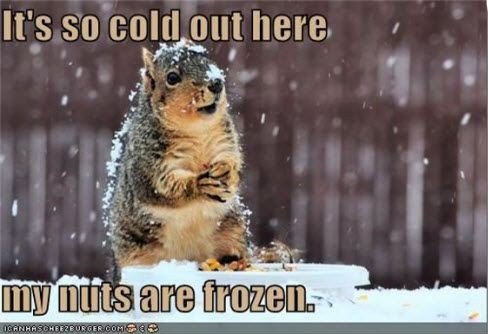We all know it’s cold, but this will seem like balmy weather when the worst hits tonight and over the weekend.
Temps are predicted to hit a high of only 14 today, 11 tomorrow, and 16 on Sunday. The nights will be worse. Only 2 tonight, -3 tomorrow, and 10 on Sunday night.
Add the windchill factors and we will experience the old Viking belief of Hell being a frozen torment, rather than one of fire.
Windchill will make real feel temps as low as -25 degrees over the next few days.
Here are some tips on protecting yourself, your home, and your pets:
- Make an emergency kit for at least three days of self-sufficiency.
- Rock salt or more environmentally safe products to melt ice on walkways.
- Keep space heater safety in mind: Use electric space heaters with automatic shut-off switches and non-glowing elements. Remember to keep all heat sources at least three feet away from furniture and drapes.
- Prepare your home:
- Make sure you have a working carbon monoxide detector.
- Keep fire extinguishers on hand, and make sure everyone in your house knows how to use them. House fires pose an additional risk, as more people turn to alternate heating sources without taking the necessary safety precautions.
- Learn how to shut off water valves (in case a pipe bursts).
-
- If you have a wood burning fireplace, consider storing wood to keep you warm if winter weather knocks out your heat. Also, make sure you have your chimney cleaned and inspected every year.
- Have at least one of the following heat sources in case the power goes out:
- Extra blankets, sleeping bags and warm winter coats
- Fireplace or wood-burning stove with plenty of dry firewood, or a gas log fireplace
- Prepare your vehicle:
- Fully winterize your vehicle: Check antifreeze, brakes, heater and defroster, tires, and windshield wipers to ensure they are in good shape. Keep your gas tank at least half full.
- Keep an extra emergency kit specifically created for your car. In addition to the basic essentials, consider adding a portable cell phone charger, ice scraper, extra blanket, sand for traction and jumper cables.
- Make sure you have a cell phone with an emergency charging option (car, solar, hand crank, etc.) in case of a power failure.
- People who depend on electricity to operate medical equipment should have alternate arrangements in place in case power is out for an extended period of time.
- Plan to check on elderly/disabled relatives and neighbors.
- Plan to bring pets inside.
- Know where the manual release lever of your electric garage door opener is located and how to operate it in case you lose power.
General Precautions
- Stay indoors unless you MUST venture outside.
- Drive only if it is absolutely necessary. If you must drive: travel in the day; don’t travel alone; keep others informed of your schedule and your route; stay on main roads and avoid back road shortcuts.
- Walk carefully on snowy, icy, walkways.
- Avoid overexertion if shoveling snow. Overexertion can bring on a heart attack—a major cause of death in the winter. Use caution, take breaks, push the snow instead of lifting it when possible, and lift lighter loads.
- Keep dry. Change wet clothing frequently to prevent a loss of body heat. Wet clothing loses all of its insulating value and transmits heat rapidly.
- If you must go outside, wear several layers of loose-fitting, lightweight, warm clothing rather than one layer of heavy clothing. The outer garments should be tightly woven and water repellent.
- Wear mittens, which are warmer than gloves.
- Wear a hat and cover your mouth with a scarf to reduce heat loss.
Cold Related Illness
- Frostbite is a serious condition that’s caused by exposure to extremely cold temperatures.
- a white or grayish-yellow skin area
- skin that feels unusually firm or waxy
- numbness
- If you detect symptoms of frostbite, seek medical care.
- Hypothermia, or abnormally low body temperature, is a dangerous condition that can occur when a person is exposed to extremely cold temperatures. Hypothermia is caused by prolonged exposures to very cold temperatures. When exposed to cold temperatures, your body begins to lose heat faster than it’s produced. Lengthy exposures will eventually use up your body’s stored energy, which leads to lower body temperature.
Warnings signs of hypothermia:
- Adults: shivering, exhaustion, confusion, fumbling hands, memory loss, slurred speech drowsiness
- Infants: bright red, cold skin, very low energyIf you notice any of these signs, take the person’s temperature. If it is below 95° F, the situation is an emergency—get medical attention immediately.
Carbon Monoxide
Caution: Each year, an average of 430 Americans die from unintentional carbon monoxide poisoning, and there are more than 20,000 visits to the emergency room with more than 4,000 hospitalizations. Carbon monoxide-related deaths are highest during colder months. These deaths are likely due to increased use of gas-powered furnaces and alternative heating, cooking, and power sources used inappropriately indoors during power outages.
- Never use a generator, grill, camp stove or other gasoline, propane, natural gas or charcoal¬ burning devices inside a home, garage, basement, crawlspace or any partially enclosed area. Locate unit away from doors, windows and vents that could allow carbon monoxide to come indoors. Keep these devices at least 20 feet from doors, windows, and vents.
- The primary hazards to avoid when using alternate sources for electricity, heating or cooking are carbon monoxide poisoning, electric shock and fire.
- Install carbon monoxide alarms in central locations on every level of your home and outside sleeping areas to provide early warning of accumulating carbon monoxide.
- If the carbon monoxide alarm sounds, move quickly to a fresh air location outdoors or by an open window or door.
- Call for help from the fresh air location and remain there until emergency personnel arrive to assist you.
Stay or Go Decision Making
STAY:
- If stuck on the road to avoid exposure and/or when rescue is likely
- If a safe location is neither nearby or visible
- If you do not have appropriate clothing to go outside
- If you do not have the ability to call for help
GO:
- If the distance to call for help is accessible and can be reached in under 30 minutes and the following two conditions exist.
- If you have visibility and outside conditions are safe.
- If you have appropriate clothing.
Pet Protection
Pennsylvania makes it unlawful to tether an animal outside longer than 30 minutes in weather under 32 degrees (and above 90).
Bundle up, wipe down
No matter what the temperature is, windchill can threaten a pet’s life. Exposed skin on noses, ears and paw pads are at risk for frostbite and hypothermia during extreme cold snaps. For this reason, short-haired dogs often feel more comfortable wearing a sweater — even during short walks.
Rock salt and other chemicals used to melt snow and ice can irritate the pads of your pet’s feet. Wipe all paws with a damp towel before your pet licks them and irritates their mouth.
Check paws for cuts that may have resulted from ice. Remove any snow matted into fur between paws.
If you have an outside water dish, it should be made of plastic in extremely cold weather. Even frozen water may attract a pet that was let outside to relieve itself. A metal dish can result in a dogs tongue freezing upon contact with the metal (remember the movie, Chistmas Story, with the kid and the flagpole?).
If you do tether your dog (even for 30 minutes) there should be a shelter for him with some type of material inside for nesting. The shelter should be positioned with the opening facing away from prevailing winds and set at least 3 inches off the ground.
Disclaimer: On January 4, 2016, the owner of WestEastonPA.com began serving on the West Easton Council following an election. Postings and all content found on this website are the opinions of Matthew A. Dees and may not necessarily represent the opinion of the governing body for The Borough of West Easton.







